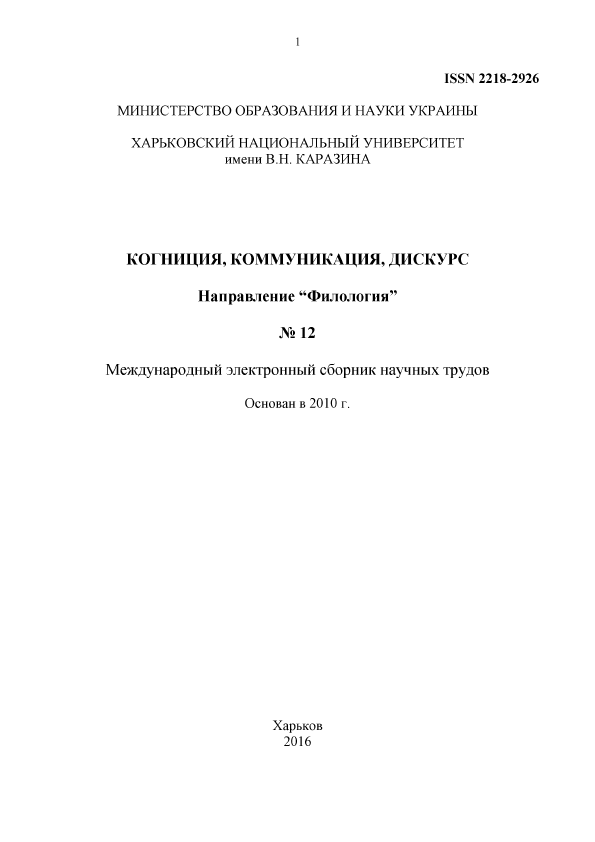General Tokens of the Phenomenon of Silence in Communicative Process
Abstract
The focus of the present article is the phenomenon of communicative silence. In our research, firstly we have tried to distinguish communicative and non-communicative phenomena of silence. The reason for our study is the existence of non-delimitating approaches in scholarly publications concerning the above mentioned notions. Taking into consideration J. Searle's definition of a minimal communicative unit we have come to
a conclusion that an essential feature of the phenomenon of silence is a definite addresser’s intention. Secondly, we further developed our approach by applying it within communicative linguistics and singled out some general manifestations of marked and unmarked instances of silence in communicative process.
Downloads
References
Austin, J.L. (1962). How to Do Things with Words. Oxford: The Clarendon Press.
Ayvazyan, A. (2014). Ֆիզիկական բռնությունը՝ որպես ոչ խոսքային հաղորդակցության միջոց քաղաքական խոսույթում [Physical Violence as a Non-verbal Communicative Means in Political discourse]. Bulletin of Yerevan “Bryusov” State University of Languages and Social Sciences, Philology, Linguistics, 1(30), 21–29 (in Armenian).
Bezuglaja, L.R. (2015). Semantika i pragmatika: k probleme sootnoshenija ponjatij [Semantics and pragmatics: on the issue of interrelation] Kognicija, kommunikacija, diskurs. – Cognition, Communication, Discourse, 10, 8–26 (In Russian).
Brutyan, L.G. (2002). Ներակայման տեսության հիմունքները [The Basics of Implicature Theory]. Yerevan: Hayastan Publ.
Danielyan, E. (2015, April 22). Obama to Again Avoid ‘G-Word’. Azatutyun.am. Available at http://www.azatutyun.am/content/article/26972764.html
Davit Khachatryan, the accused in Lyuks Stepanyan’s murder, has sewed his mouth. (2014, May 14). Iravaban.net. Available at: http://iravaban.net/en/57438.html
Ephratt, M. (2008). The functions of silence. Journal of Pragmatics, 40, 1909–1938.
Jaworski, A. (1993). The Power of Silence; Social and Pragmatic Perspectives. London: SAGE Publ.
Melikyan, S.V. (2000). Rechevoj akt molchanija v structure kommunikacii. Diss. kand. filol. nauk. [Silence speech act in structure of communication. Cand. philol. sci. diss.]. Voronezh. Available at: http://31f.ru/dissertation/434-dissertaciya-rechevoj-akt-molchaniya-v-strukture-kommunikacii.html (in Russian)
Obama, B. (2010, April 24). Statement of President Barack Obama on Armenian Remembrance Day [The White House Statements and Releases]. Available at: https://www.whitehouse.gov/ the_press_office/Statement-of-President-Barack-Obama-on-Armenian-Remembrance-Day/
Picard, M. (1952). The World of Silence. Chicago: Henry Regnery Publ.
Searle, J.R. (1996). What is a Speech Act? In: A.P. Martinich (Ed.). The Philosophy of Language (pp. 130–140). New York and Oxford: Oxford University Press.
The Constitution of the Republic of Armenia. Chapter V. Available at: http://www.parliament. am/parliament.php?id=constitution&lang=eng#5
The Law of the Republic of Armenia: Rules of Procedure of the National Assembly [Electronic Resource]. (2002). Available at: http://www.parliament.am/legislation.php?sel= show&ID=38&lang=eng
The Traffic Rules of the Republic of Armenia [Electronic Resource]. (2013). Available at: http://www.police.am
Vasilik, M.A. (Ed.). (2006). Osnovy teorii kommunikacii [Basics of the Theory of Communication]. Moscow: Gardariki Publ.
Authors, who publish with this journal, accept the following conditions:
The authors reserve the copyright of their work and transfer to the journal the right of the first publication of this work under the terms of the Creative Commons Attribution License (CC BY), which allows other persons to freely distribute a published work with mandatory reference to the authors of the original work and the first publication of the work in this journal.
Authors have the right to enter into separate additional agreements for the non-exclusive dissemination of the work in the form in which it was published by this journal (for example, to post the work in the electronic institutions' repository or to publish as part of a monograph), provided that the link to the first publication of the work in this journal is given.
The journal policy allows and encourages the authors to place the manuscripts on the Internet (for example, in the institutions' repositories or on personal websites), both before the presentation of this manuscript to the editorial board and during review procedure, as it contributes to the creation of productive scientific discussion and positively affects the efficiency and dynamics of citing the published work (see The Effect of Open Access).




